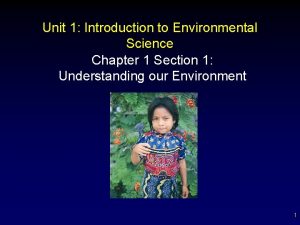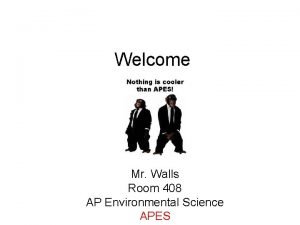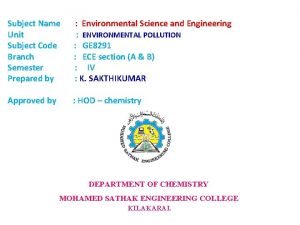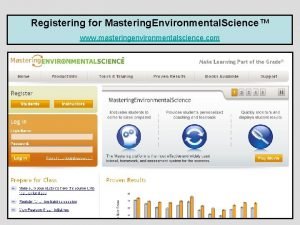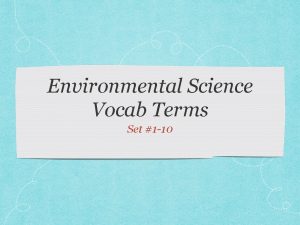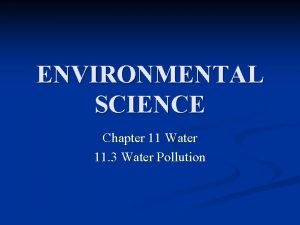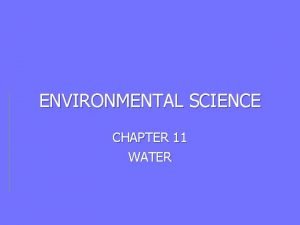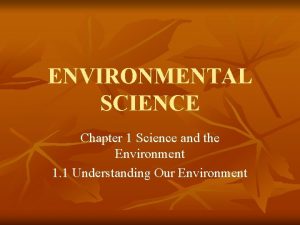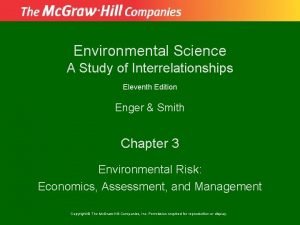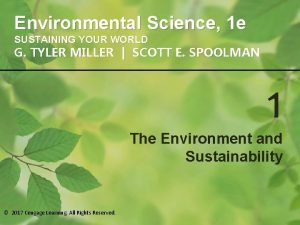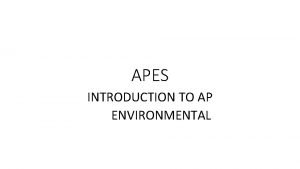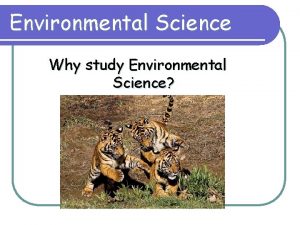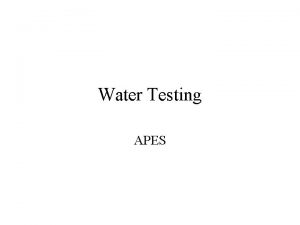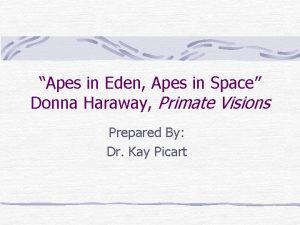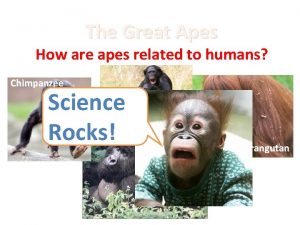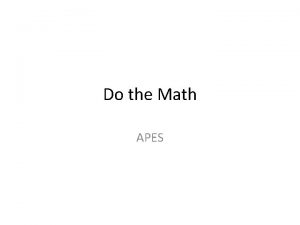INTRODUCTION TO AP ENVIRONMENTAL SCIENCE APES INTRODUCTION TO
















- Slides: 16

INTRODUCTION TO AP ENVIRONMENTAL SCIENCE APES

INTRODUCTION TO ENVIRONMENTAL SCIENCE • Environment • External conditions that affect living organisms • Ecology • Study of relationships between living organisms and their environment • Environmental Science • how nature works. • how the environment affects us. • how we affect the environment. • how we can live more sustainably without degrading our life-support system.

Sustainability • The ability of a specified system to survive and function over time * Natural capital refers the land, air, water, living organisms and all formations of the Earth's biosphere that provide us with ecosystem goods and services needed for survival and wellbeing. * An environmentally sustainable society meets basic needs of its people without degrading the natural capital that supplies their ecological services.

Earth Resources Renewable Non-Renewable Potentially Renewable Direct solar energy Fossil fuels Fresh air Winds, tides, flowing water Metallic minerals (iron, copper, aluminum) Fresh water Nonmetallic minerals (clay, sand, phosphates) Fertile soil Plants and animals (biodiversity)

Four Global Environmental Problems 1. Over population 2. Pollution 3. Global Warming 4. Loss of biodiversity

POPULATION GROWTH

Pollution & Global Warming • Pollution is any addition to air, water, soil, or food that threatens the health, survival, or activities of humans or other living organisms • EXAMPLE: Burning fossil fuels ( oil, natural gas , and coal) has caused increases in global carbon dioxide • CO 2 blocks infrared radiation and therefore traps heat in the atmospheric • Results in displacement of plants, rise in sea level, changes in climate and weather

Loss of Biodiversity • Increasing population will increase resource consumption which converts forests, grasslands, wetlands, etc. to agriculture and urban development • Loss of these ecosystems leads to loss of biodiversity of all organisms • Biodiversity is needed for the sustainability of crop (food) and medicine development • Biodiversity is critical in maintaining stability in all natural systems

It is a measure of how much biologically productive land water (cropland, grazing land, forest and fishing grounds) is required to produce all the resources (food, timber, building materials, fuel, water) an individual or a population consumes and to absorb the waste they generate.

Ecological Footprint Measurements The measuring units used in Ecological Footprints are in global HECTARES (g. Ha) Ex. A hectare of land includes it’s “bio-productive capacity” (from nutrient cycling, energy production, etc. ) A hectare = 2. 5 acres (1 hectare is 2 complete football fields with end zones) Footprint Component Definition Carbon uptake Calculated as the amount of forest land required to absorb CO 2 emissions from burning fossil fuels and chemical processes Grazing land Calculated from the area used to raise livestock for meat, dairy , wool, hide Forest Calculated from the amount of lumber, pulp, and fuel wood consumed Fishing grounds Calculated from the production required to support the fish(seafood) caught Cropland Calculated from the area used to produce food and clothing for humans and feed for livestock Built-up Land Calculated from the area of land required for construction, transportation, and industrial structure

Our Ecological Footprint Current estimates indicate that humans are over-shooting the Earth’s carrying capacity (bio-capacity) by 25 -50% To sustain the current carrying capacity, we need 11/2 Earths!

THE “COMMONS” – RESOURCES SHARED BY ALL AIR WATER LAND OCEANS NATIONAL PARKS

What is the “Tragedy of the Commons”? • ARTICLE: published in 1968 by Garrett Hardin. • CONCEPT: a shared resource in which any given user reaps the full benefit of his/her personal use, while the losses are distributed amongst all users. Result? Tragedy of resources. • CLASSIC EXAMPLE: excessive cows on shared pasture overgraze and degrade the land Individuals are motivated only by personal gain of wealth while degrading environment Is of concern because it may convert potentially renewable resources into nonrenewable resources

GEOLOGICAL TIME SCALE *The history of the Earth is measured in Geological Time *It is organized according to major events *The largest unit of time is EON ERA PERIOD EPOCH

IMPORTANT STAGES IN EARTH’S HISTORY *4. 6 BILLION YEARS AGO (HADEAN EON) *3. 5 BILLION YEARS AGO (ARCHEON EON/PRECAMBRIAN ERA) *2. 5 BILLION YEARS AGO(PROTEROZOIC EON/PRECAMBRIAN ERA) *1. 5 BILLION YEARS AGO(PROTEROZOIC EON/PRECAMBRIAN ERA) *550 MILLION YEARS AGO(PROTEROZOIC EON/ PALEOZOIC ERA/CAMBRIAN PERIOD) *450 MILLION YEARS AGO (PHANEROZOIC EON/PALEOZOIC ERA/ ORDOVICIAN PERIOD) = = ORIGIN OF EARTH- NO LIFE FIRST PROKARYOTIC CELL- LIFE ATMOSPHERIC OXYGEN EXISTS FIRST EUKARYOTIC CELL = PRIMITIVE ALGAE/MARINE INVERTEBRATES = FIRST MARINE VERTEBRATES (FISH) *400 MILLION YEARS AGO (PHANEROZOIC EON/ = FIRST LAND INVERTEBRATES & PLANTS *200 MILLION YEARS AGO (MESOZOIC ERA/TRIASSIC PERIOD) = FRIST BIRDS/ROCKY MOUNTAINS FORM *150 MILLION YEARS AGO (MESOZOIC ERA/JURASSIC PERIOD) = AGE OF DINOSAURS *65 MILLION YEARS AGO(CENOZOIC ERA/TERTIARY PALEOGENE PERIOD) =EXTINCTION OF DINOSAURS PALEOZOIC ERA/SILURIAN PERIOD) PALEOCENE EPOCH) • 2 MILLION YEARS AGO(CENOZOIC ERA/QUATERNARY PERIOD) • PLEISTOCENE EPOCH) =FIRST MAN/MAMMALS/INSECTS/FLOWERS

EARTH’S INTERACTIVE COMPONENTS GEOSPHERE = makes up the Earth’s interior (rock) ATMOSPHERE = makes up the gases surrounding Earth (air) HYDROSPHERE= makes up the areas of water BIOSPHERE = makes up all the living things within the other parts GEOSPHE RE EARTH IS AN INTEGRATED SYSTEM OF 4 INTERACTING COMPONENTS
 Tragedy of the commons
Tragedy of the commons Unit 1 introduction to environmental science
Unit 1 introduction to environmental science Paragraph on my favourite subject science
Paragraph on my favourite subject science Mh 605
Mh 605 Science fusion digital lessons
Science fusion digital lessons Ap environmental science exam pass rate
Ap environmental science exam pass rate Tragedy of the commons easter island
Tragedy of the commons easter island Environmental science and engineering subject code
Environmental science and engineering subject code Masteringenvironmentalscience
Masteringenvironmentalscience Environmental science defination
Environmental science defination Environmental science vocabulary
Environmental science vocabulary Dinoflagellates
Dinoflagellates Ap environmental science chapter 11
Ap environmental science chapter 11 Is water that contains waste from homes or industry
Is water that contains waste from homes or industry Environmental science chapter
Environmental science chapter Tragedy of the commons environmental science
Tragedy of the commons environmental science Ipat model of environmental impact
Ipat model of environmental impact

